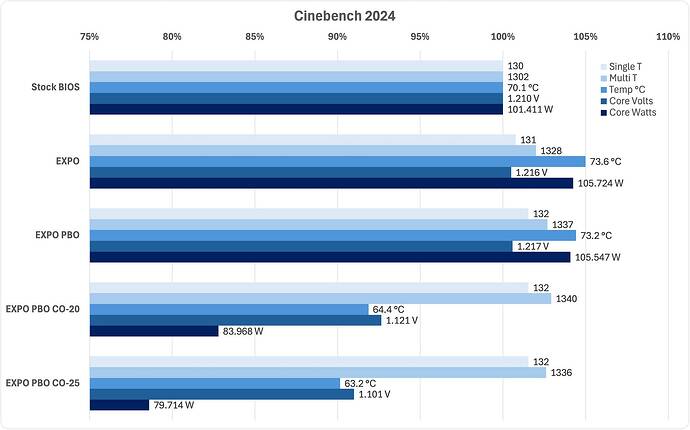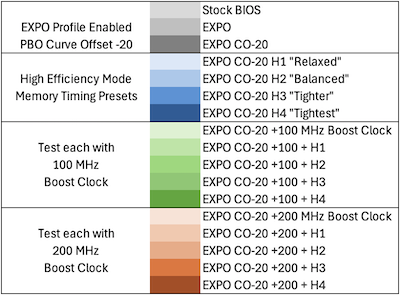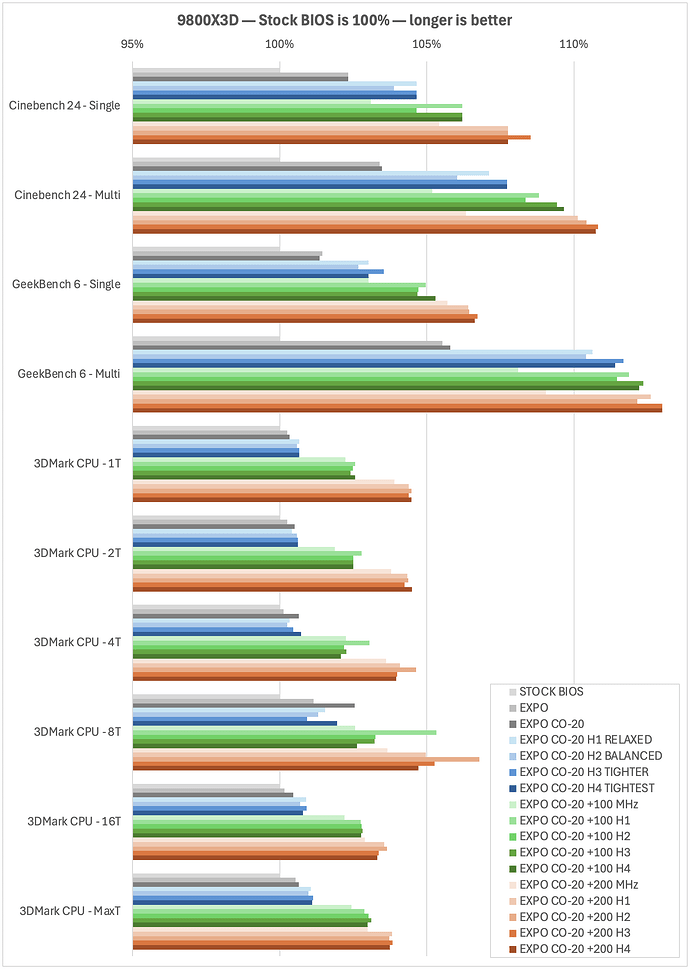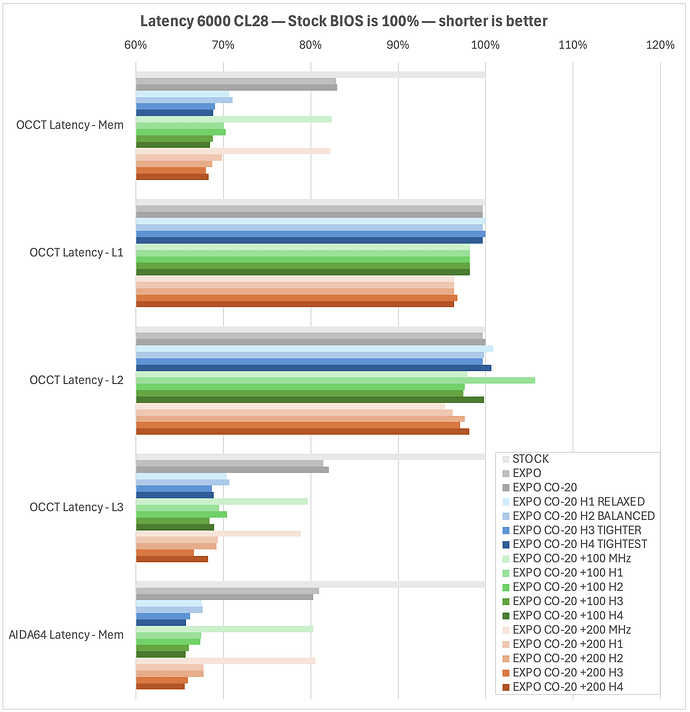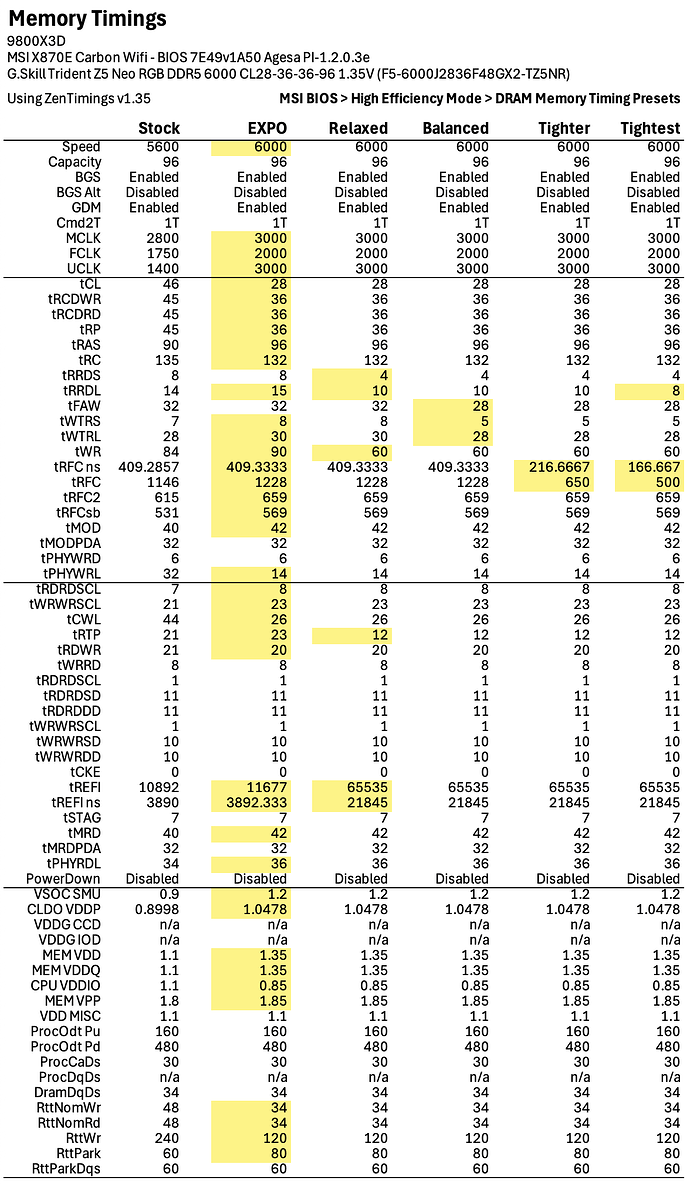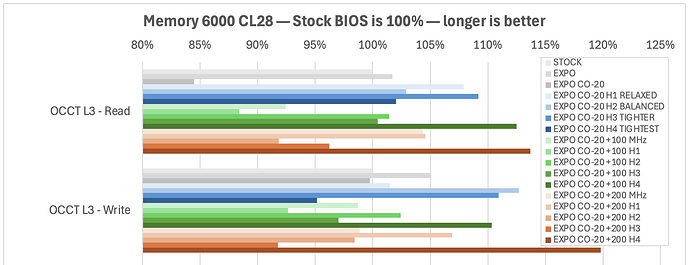I run a 9800x3d and a 4090 with an older 240mm AIO (2 fans) mounted on top and have no temp problems. Runs about 45 degrees at idle and 65-70 degrees running MSFS 2024.
You can never have too much cooling! Your sim temps are spot on however try running Prime95 for 30 minutes to see how your system holds up. My 9950x3d will max out at 90-92c (at 95c it will throttle but never goes that high) and with some calculations require 267w continuous (275w peak) as measured by cpu package power. Prime95 will stress your cpu & memory to the max so make sure you monitor your temps.
I finally got Windows 11 installed and started testing my new PC (coming from the Mac world…) and I’m both relieved and impressed so far.
I have a 9800X3D and Samsung 9100 Pro 2TB both in a water loop (no GPU yet) that has 3x 420 radiators, and 9 Arctic P14 Max fans.
First run of Cinebench with completely stock BIOS settings, default Windows, etc, D5 Pump speed of about 70% or 4000 rpm 100 l/hr, and fans at about 50%… CPU didn’t go above 70 degrees.
Then when I set EXPO and PBO on, with a negative 20 curve offset (which I think is ‘undervolt’) and set to throttle at 85 degrees… Cinebench overall power draw was under 110 W and temps barely broke 60 degrees. I tried AIDA64, and a few others, with similar results.
The Aquacomputer software (Aquasuite) is pretty easy once you figure it out, and I could set both the pump and fan speeds based on a combination of coolant and component temps, so it ramps up under stress, but so far not needing to go over 70% pump speed.
The real test will be with a GPU, which is the main heat producer, but after months of stressing about this, I’m pretty thrilled with how it has turned out so far.
That’s great. For reference, my setup is:
7950X3D (be quiet! Deep Cool 4 aircooler)
3090 Ti (450W TDP) (liquid-cooled)
(1) 280mm top-mount radiator with 2x high static-pressure push fans.
Corsair XD5 pump/reservoir connected to the motherboard.
I have the pump set with a pretty mild speed curve, running at 30% up to around 50°C, ramping up to 50% when the GPU hits 60°, and 90% when it hits 80°C.
Both CPU and GPU stay right around 70°C during flight.
The GPU is slightly undervolted, and the CPU uses PBO2 Auto.
I do not use any additional cooling on my SSD’s or RAM, and their temps are fine - usually 35-45°C.
When undervolting your cpu, I highly recommend the Corecycler utility. Here is a good article explaining it. Some additional recomendations if you use it:
- in step 7 use motherboard limits to get the best performance.
- in step 9, set the scalar to 10 which will allow the cpu to boost more aggressively
- in step 10, set the boost clock to 150
For the Corecycler itself, I’ve never needed to change any of the defaults
Also, setting your throttle at 85c is well below the thermal throttle limit of the 9800x3d at 95c (tjMax) so you are definitely leaving some performance on the table. Undervolting will lower the cpu temps which will allow more headroom for the cpu to safely boost higher and longer before it hits its default thermal throttle limit of 95c.
Thanks for the tips
I did set PBO to use Motherboard defaults, and I added the 85 degree throttle to be safe.
I’m OK with that for now, mostly because running all the various benchmark and stress tests - Cinebench, AIDA64, Prime 95 - so far the maximum CPU temperature has hovered under 80 degrees, safely shy of the 85 throttle - which I’m really happy about.
That’s with CPU running 100%, about 5225 MHz sustained, the water pump at 80%, and fan curves at that CPU temp are about 75% I think, keeping it cool and fairly quiet.
I won’t push any further with customization until I’ve got a GPU and MSFS installed to see how it performs in its intended scenario first. Baby steps, as this is my first PC build, and water loop - the chances of me screwing up were greater than zero percent, but so far so good!
Maybe someone smarter than me can chime on my belief that a CPU boost clock continues to increase until it reaches its thermal limit or voltage limit. IOW, if you set the thermal limit to 85°C you’re leaving a (small) amount of boost on the table.
I personally set mine to 89°C and only see it hit that temp under extreme load like the Prime95 Small FFT test.
So the question remains: If I never exceed 70°C in the sim, does setting a thermal limit even matter?
I have zero experience, but conceptually, if enabling PBO effectively removes the stock safety limits, I like the idea of having some upper limit for insurance, in case of a runaway heat event
In my case, if the CPU goes above 85 it’s likely the pump or fans have stopped, so I feel better having at least some guardrail there.
And if it turns out under maximum legitimate load, it still wants to go above 85, I’ll raise it like you have done, but still try to keep it under the CPU’s max of 95.
I get that. I remember watching a video (JayzTwoCents, I think) where he talked about air-cooled vs. liquid cooled. One of the ppoints he made was that an air-cooler can react much more quickly (because of the specific heat of water) than a liquid cooler, which could be beneficial if you get a fast spike in CPU temp.
Another thing I remember reading somewhere that kind of blew my mind, is that a delidded CPU with no cooling would completely fry within seconds of turning the computer on.
Crazy how many kilocals the cooling system has to transfer.
I installed my first water cooler in my 9800X3D build earlier this year so everything was new to me. I was concerned about delayed response to CPU temp spikes. The solution that I read somewhere was to keep the pump running at - or close to - 100% regardless of CPU load and temperature. The fans can be controlled via the CPU temperature as normal. This means that, should the CPU temperature spike, you already have maximum cooling available. This gives the cooler fans some time to spool up in case the increase in CPU power/temperature is sustained for some time. Noise is typically generated by fans while the pump is quite quiet, so you do not have a lot of unnecessary noise with this strategy.
So far it has been working well for me.
Basically, water is denser (more thermal mass) and can absorb and move heat away from a component much faster and more efficiently than air.
Then as long as you have enough radiator surface area and airflow, its easy to keep the coolant temp low.
JayzTwoCents did a test recently showing that pump speed of about 80% resulted in lowest temps (under load).
I’ve set a pump curve from about 60 to 100% based on coolant temp (and will add in a factor that includes CPU and GPU temps).
I’ve set the fans to ramp up with CPU temp, from about 30% up to 100%.
I’m still experimenting, and it will change once a GPU is in the loop, but so far when CPU is in the Prime 95 torture test, pump at 80% and fans around 75 to 80, is keeping the CPU temp below 80 degrees.
Of course every loop is different. I went for the max I could fit: 3x 420mm rads. 2 are 45mm thick, and back one is 30mm but higher density fins. I chose Arctic P14 Max fans because they were inexpensive but have great static pressure for rads, which helps avoid having to run full speed.
I also used the largest volume reservoir that would (just) fit, to have coolant volume (about 1.5 L in the loop!). Last the fittings can add resistance, like the 90 angles and 2 quick disconnects I put in (already glad I did because I had to re-seat the M.2, and it was easier not having to drain everything.) But so far, luckily, it has all worked out better than I hoped.
Here is the rudimentary monitor I put together in Aquasuite, running the Prime 95 Blend, Large FFT and Hardest Small FFT tests. I think it’s largely the volume of coolant and large water block on the CPU keeping it cool, and I can probably tune the fans lower to be a bit quieter.
Yes, but if you’ve set the the throttle temp to only 85c, respectfully whats your point? All AMD ryzen cpu’s have a feature in that when the cpu hits tjMax limit (95c for the 9800x3d), it will throttle back to lower its temps to prevent any damage. If the chip is damaged by some unforeseen circumstance, it’s under warranty and AMD will replace it. The only reason to really keep the cpu below its tjMax limit is that the throttling reduces performance.
I wasn’t really making a point, only reporting my progress. But I also get your point that I’m being too conservative with the 85 degree protection. I set it because it was a pre-set option in the MSI BIOS, and to have protection in case I messed up. I don’t want the CPU to go anywhere near it’s 95 C limit until I understand how the cooling is working, and what each optional setting does.
My goal in building a water cooled pc for flight sim, is to get the maximum specs I can afford, and to try to keep component temperatures as low as possible under full load - all so that it has a better chance at performance, stability and longevity. My priority is effective cooling with EXPO and the basic PBO enabled. I’m not really trying to tinker with maximum overclocking.
The official specs for MSFS and XPlane are much lower than what I’ve put together, but I wanted more RAM (96 GB), more VRAM (hopefully 32 GB if I eventually get a 5090), PCIe 5 SSD, and more cooling to handle it all. This is an experiment for me to see how MSFS can run when the traditional limitations are pushed, giving some extra headroom across the board.
For my own purposes, being able to get the CPU Torture Tests to run at full speed while keeping temperatures well under the 95C threshold of the CPU means that (so far) I’m accomplishing my goal. I set the 85 for my own safety, and because it was a pre-set, and mentioned by others. This is just a step in my learning process.
I know from reading that I could add boost clock and scalars (which I still don’t understand), but I’m not sure I need them, and will wait to see how a complete system runs before messing further.
Thanks for all the feedback - I do appreciate it.
I can see how benchmarking is almost a sport… It was too hot outside this week so I tried to learn about AMD’s Precision Boost Overdrive settings. I’ve gained some respect for the hardware reviewers who do in-depth benchmarking - it’s a lot of work to figure out a consistent process, and to have the patience to let each test run with different settings.
So far my best result seems to be the basic EXPO + PBO with a Curve Offset of -20. A small increase in Cinebench scores, and much cooler temps. Any more offset (less voltage) has minimal benefit and at -30 starts to fail AIDA64 and OCCT memory tests.
I’ll do some runs with “tighter timings” and also adding 100 to the boost clock. But I’m not touching the “Scalar”, now that I know what it does.
And for anyone using test software, watch out for Prime95, it really hits the power / temperature limits, even with water cooling and negative Curve Offset in voltage - it always maxed out the Core Power Wattage (120W) which is a little scary. But I’m really happy with the water cooling so far.
Testing 9800X3D in MSI X870E Carbon board, BIOS 7E49v1A4 (Agesa 1.2.0.3c)
and G.Skill Ram 6000 CL28-36-36-96 1.35V
Ambient Room temp was about 30C!
Nice work there.
Posting some test results in case it helps anyone else tuning their 9800X3D. I went a little OCD wanting to understand the tuning options.
My first surprise was that “tightening” memory timings (actually subtimings) using presets in the MSI motherboard BIOS has the greatest effect, at least on benchmarks (see charts below).
The MSI BIOS under EXPO it offers “High Efficiency Mode” with 4 Memory Timing Presets to adjust the memory subtimings (details below):
- Relax
- Balanced
- Tighter
- Tightest
EXPO itself reduces memory latency by about 15-17%, but enabling any of the High Efficiency Mode presets further reduces it by another ~15%.
2nd surprise is the OCCT Memory test of the L3 Cache is all over the place with Boost Clock enabled… it could just be the way OCCT does its tests…
L3 Cache benchmarks in OCCT all over the place
I have no idea if this is meaningful. All the other Memory data is consistent, just OCCT and the L3 Cache look like this.
My basic conclusions so far:
- Enable EXPO (assuming RAM is on Motherboard QVL) reduces memory latency
- Enable a PBO Curve Offset to lower voltage, power and heat, which provides thermal headroom
- BIOS likely has some profiles for tightening memory subtimings, and if available, can really improve memory latency (and at least benchmark scores)
- Adding 100 or 200 MHz boost clock has a much greater impact when combined with tightening memory subtimings. Just make sure you have good cooling - when I added the boost clock, it did push thermals up.
- I have yet to run long stability tests, which would be essential after trying any of the above.
Your OCD tickles my empirical dopamine receptors… ![]()
(In other words…GREAT WORK!)
Thanks - It’s a result of not having a GPU yet, so I can’t fly.
Also caught between greed and fear - I want the most reasonable performance I can get, but also want it to last. Seeing the videos of 9800X3Ds burning up made me wary of following blindly… The sport of benchmarking seems to chase results at the risk / expense of longevity. I can’t afford to burn a new CPU!
It’s really the sport of overclocking that threatens our silicon masters.
I think it’s important to understand a few important settings, and keep them within sensible limits.
Th easiest way to do that is keep motherboard settings mostly default, the exceptions being:
- PBO 2 Curve
- EXPO/XMP
- (Maybe) lower PPL1 and PPL2 limits (depending on CPU cooling.)
One MASSIVE problem is when motherboard manufacturers (ASUS ![]() ) try to push performance by setting destructive defaults. We think we’re playing it safe, but they’ve doomed us from the start with their greed.
) try to push performance by setting destructive defaults. We think we’re playing it safe, but they’ve doomed us from the start with their greed.
There are a few folks here (like @WingWarper1 who have gotten a lot further with OC than I have.) They persevered and are getting some amazing benchmark results. I’m not nearly as bold.
Good advice. I’m keeping almost everything Auto, especially the PBO power limits, which keeps the TDP limit at 120W. In my first few tests with changing limits to Motherboard, I didn’t like how some tests went over the limits too often and for too long for comfort, without much gain in results. The water cooling keeps the max temp to about 80C, but I still don’t like going over the Watts or Amps limits.
I’m pretty sure the Boost Clock is safe - PBO will allow adding up to +200 MHz, but it will plateau and pull back when it approaches the Voltage, Watts, Current or Temperature guardrails in its algorithm (which is why I’m keeping Auto power limits for now).
Scalar on the other hand is only if you want to push it past it’s “warranted silicon stress level” to chase higher performance at the risk and expense of longevity - which I do not. It effectively lies, telling it the silicon is better than it really is, and to push the limits.
I’m pretty sure 5.2 GHz is going to be ample, and all I’m trying to do is use the Curve Offset to undervolt for power and thermal savings, and maybe make use of the headroom it creates with the minor boost clock.
What I’m reading about now is changing the All Core Curve Offset to be Per Core - since a few cores can only undervolt so far, holding back the rest. I’m happy with the -20, but if I can figure out which cores are limited, I might be able to drop the rest to -30. That way all cores can reach their max frequency / voltage sweet spot.
If I get really bored (still saving for that GPU…) I’ll try the Curve Shaper - which allows custom curve offset values along the Voltage Frequency curve, but it looks mind numbing, and probably not necessary.
It’s interesting, and I’m glad to be sitting out SU3 beta. I hope getting this up and running coincides with a stable version of 2024!

